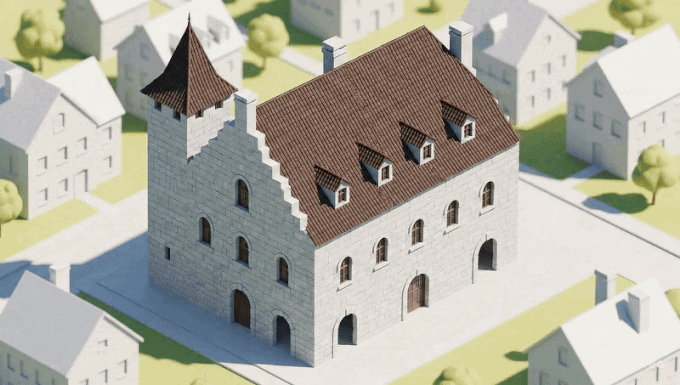Do We Live in an Architectural Golden Age or Soul-Crushing Dystopia?
There has never been a better time to indulge personal aesthetic tastes.
Political commentator Tucker Carlson isn’t shy about expressing his opinions, whether the topic is building political coalitions or building buildings. He once bemoaned “the oppression of post-modern architecture, which is designed to … destroy your spirit.”
Carlson considered Moscow an exception − prompting one commenter to retort that Moscow is filled with “spirit-destroying architecture. … The vast majority of the city is Soviet-built grey cement rectangles as far as the eye can see.”
Carlson and his political foes seem to find rare common ground in viewing modern architecture as soul-crushing. Data shows more traditional designs are widely preferred on a bipartisan basis. Recent polling by the National Civic Art Society found that 72 percent of Americans across political, racial, gender and class lines prefer traditional architecture for U.S. courthouses and federal office buildings.
During his first administration, President Donald Trump even issued an executive order intended to “Make Federal Buildings Beautiful Again.” (It was later overturned.)
Traditional architecture is really a broadly held preference. The aforementioned 2020 poll shows that support for traditional design crosses political lines, with large majorities of Democrats (70 percent), Republicans (73 percent) and independents (73 percent) all favoring it.
Modern Technology Makes Preservation Work Easier
I count myself among those who favor traditional architecture. There’s no shortage of fascinating contemporary work, from Zaha Hadid’s bold experimentation to curiosities like Switzerland’s recent 3D-printed tower. Yet for me, and for many others, the enduring beauty and detail of older architecture simply hold greater appeal.
There’s encouraging news for those of us who appreciate traditional architectural styles and rich ornamentation.
There has arguably never been a better time to indulge personal aesthetic tastes. Whether your preference leans toward minimalism or ornate detail, brutalism or baroque grandeur, modern technology has dramatically reduced the cost and complexity of building, restoration and renovation.
Artificial intelligence could be used as a tool to restore medieval European cathedrals while robotic arms could assist traditional Bhutanese craftsmen in carving intricate designs into wood.
At no point in history has it been easier or more accessible to customize one’s environment. Recently, a Danish man renovated his plain-looking home into a miniature medieval castle, complete with a functional drawbridge and a moat.
However, this trend extends well beyond eccentric personal projects.
Architectural Traditions Are Worth Preserving
Many large-scale structures also pay tribute to the past. A museum built in 1966 in California was designed in the style of an ancient Egyptian temple. Another Californian museum that opened in 1974 emulates a palatial ancient Roman villa.
The Wat Rong Khun, a Buddhist temple built in 1997, features intricate carving in the style of classic Thai architecture. An enormous church in Belgrade, Serbia, displays stunning and meticulously crafted Byzantine details.
Entire neighborhoods are embracing historic styles, too. Poundbury in the United Kingdom, a new take on traditional British architectural heritage championed by King Charles III, exemplifies this trend.
The riverside town of Occoquan, Virginia, features a district filled with newly constructed homes in a charming Victorian style. The homes’ paint colors were painstakingly sourced from historical period references. The result is indistinguishable (at least to my eyes) from a well-preserved genuine Victorian neighborhood.
Not only can modern people recreate traditional aesthetics, humanity is getting better at preserving the authentic architecture that has managed to survive from past eras.
The restoration of the medieval Notre Dame Cathedral in Paris after it was partially destroyed in a fire in 2019 demonstrates how modern people can bring back ancient architectural majesty.
When Notre Dame reopened in December 2024, the cathedral had the same ornate Gothic beauty as before, in addition to newly installed cutting-edge fire prevention systems. News reports noted in awe how “concerns in the wake of the fire that the craftsmanship required to build the cathedral in the Middle Ages no longer existed in modern times” proved false.
Humanity has the means to revive the ornate aesthetics of the past, but of course some people prefer modern minimalism.
Notre Dame now features a bronze altar in a style labeled “noble simplicity,” in sharp contrast to the surrounding building with its Corinthian columns, stained glass windows, carved gargoyles, pointed arches, ribbed vaults and flying buttresses.
This juxtaposition is telling. Ultimately, whether traditional architecture moves you or modern aesthetics inspire you, you are living in a remarkable era, a true golden age of architecture where every style thrives.
This article was published in USA TODAY on 7/29/2025.



